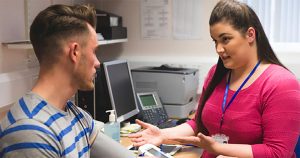Search on Google for technology in healthcare. The results will include the latest medical devices, biosensors, robotics, and such. These innovations are doing amazing things to improve medical procedures and outcomes. But the patient experience extends beyond robots and devices.
At the very core, healthcare is about collaboration between caregivers and patients. The most elemental part of health care is people interacting with people. Where does technology come into the equation? Collaboration technology, especially incorporating video conferencing, can:
- Allow people in remote areas access to care that would otherwise require hours of travel
- Leverage specialists across facilities to provide specialized expertise to more patients
- Help caregivers confer across geographies to address complex cases
All the while, performance and growth are top of mind for healthcare CIOs. Healthcare organizations have to allocate spending like any other business. Where do you put the dollars to deliver the most benefit? Here again, collaboration technology provides benefits – both for providers and patients.
 Video appointments can provide an efficient option in many scenarios. Remote appointments are often more cost-effective, minimizing the impact on medical staff and services. For example, a video consult can help a caregiver route a patient to a specialist without an in-person appointment for a referral. In Houston, Texas, 911 call-center medics triage patients to assess their immediate needs, often avoiding expensive ambulance rides (see video below).
Video appointments can provide an efficient option in many scenarios. Remote appointments are often more cost-effective, minimizing the impact on medical staff and services. For example, a video consult can help a caregiver route a patient to a specialist without an in-person appointment for a referral. In Houston, Texas, 911 call-center medics triage patients to assess their immediate needs, often avoiding expensive ambulance rides (see video below).
Up to 77% of U.S. consumers would consider a virtual visit with a healthcare provider—and 19% already have—according to a survey from The Advisory Board Company.
In a 2017 Reach Health study, 93% of healthcare professionals identified “integrated audio and video for live patient engagement” as the most valuable feature of telemedicine systems. The study also identified top objectives for telemedicine programs as follows:
- Improve patient outcomes
- Increase patient engagement and satisfaction
- Improve patient convenience
- Provide remote/rural patients with access to care
- Improve leverage of limited physician resources
Read on for examples of how organizations worldwide are improving patient care and business processes:
- North and East London Commissioning Support Unit
- NYC Health + Hospitals
- Ontario’s London Health Sciences Centre
- The Steadman Clinic
- Lee Memorial Health System
- City of Houston Emergency Services
.
UK’s North and East London Commissioning Support Unit (NEL CSU)
NEL CSU worked with Stellar Healthcare to create HealthConnect, a cloud-based service for booking secure video consultations with doctors. When patients call to make appointments, receptionists do initial triage to identify appropriate cases for video calls.
The service has proved very popular with patients. Wait times are shorter and patients can meet with their general practitioners from home, or even work. This is especially helpful for patients with full-time jobs, young children, chronic conditions, or restricted mobility. Everything runs on the UK’s National Health Service N3 network, ensuring information remains private.
“Using video has improved the quality of remote consultations and makes our support more appropriate to each individual. It also appeals to younger and tech-savvy patients.”
Debbie Bodhanya, CEO, Stellar Healthcare
Stellar Healthcare estimates that video consults could reduce missed appointments by 40% while improving the productivity of consulting time up to 70%.
Learn more about how NEL CSU and Stellar Healthcare are working together in the full case study.
New York City’s Correctional Health Services
Reaching an oft-forgotten population
NYC Health + Hospitals is the largest municipal health care system in the United States. Within it, the division of Correctional Health Services maintains a clinic presence at each of the City’s 12 jails. In the past, the jails had to transport inmates to public hospitals for specialist care. Not only was this expensive and time-consuming, but had obvious security risks.
“Many specialist care interactions do not require a live visit with the patient. In those situations, telehealth is an ideal solution.”
Dr. Erick Eiting, Correctional Health Services Director of Specialty and Emergency Services
Omitting transport also helps patients. “Patients are also in a better frame of mind to interact with us because they haven’t just been through a grueling transportation experience,” says Dr. Vingh Pham who sees patients from Bellevue Hospital. “Every telehealth session has ended on a positive note, with no security incidents.”
“Telehealth is also more flexible—we can jump from facility to facility and schedule back-to-back sessions without moving anyone,” says Dr. Eiting. “We’re getting a lot more done in a lot less time.”
Learn more about how NYC Health + Hospitals is improving healthcare for the correctional services population.
Ontario, Canada’s London Health Sciences Centre
Boosting productivity and improving training
With 15,000 employees, London Health Sciences Centre and St. Joseph’s Health Care London is using collaboration technology to reduce travel, streamline workflows, and improve communications between specialists.
“Having a solid platform for digital healthcare is vital. We’re able to work more efficiently, flexibly, and securely, and deliver better outcomes and quality of care to our patients.”
Glen Kearns, CIO
Like many hospitals, pagers were still prevalent at London Health Sciences, with 6,000 staff members using them. Moving 2,000 users to Cisco Jabber has both reduced costs and boosted productivity. For example, clinicians can view the availability of colleagues and use chat to resolve issues in real time.
The video element of Cisco WebEx has also had a huge impact. Beyond time efficiency, WebEx allows the hospital to train users in diverse locations over a single session. With Canada’s annual minimum requirement for 50 hours of training per physician, video solutions help save time. It adds up: Saving about 100 hours of a doctor’s time each year translates to up to 600 additional patient consultations.
Learn more about how London Health Sciences Centre is using collaboration solutions to improve business processes.
The Steadman Clinic
Advancing sports medicine and orthopedics
The Steadman Clinic is a world renowned orthopedic institute that specializes in performing complex surgeries. Patients come from all over the world to be treated by the clinic’s surgeons.
“[Cisco] Spark is a unique technology that allows for collaboration across all aspects of a business, an organization, and, for us, the health care delivery.” Dan Drawbaugh, CEO, The Steadman Clinic
Implementing Cisco Spark and devices like Cisco Spark Board has allowed The Steadman Clinic to improve communication within the organization as well as with other medical facilities worldwide.
Lee Memorial Health System
Saving critical minutes with mobile video
Lee Memorial Health System implemented has “mobile telestroke carts” to expand stroke care services across its hospitals. When patients arrive in the emergency room with stroke symptoms, the staff uses the carts to connect remote doctors to patients using Cisco video conferencing and Jabber.
These quick connections with on-call physicians can help save crucial minutes in treatment. Neurologists can evaluate a patient within minutes of the ER physician’s call from any remote location. After an assessment, the neurologist is immediately accessible to consult with the care team over video.
“There are obvious benefits to our community in the level and speed of care we’re able to provide.” Dr. William Carracino, neurologist, Lee Memorial Health System
The solution also gives patients more face-to-face time with doctors because doctors spend less time moving between patient rooms.
Read more about the telestroke carts at Lee Memorial Health System in the full case study.
City of Houston Emergency Services
Use our case study index to search by industry, technology, location, or products to find more case studies about organizations using Cisco collaboration technology.


Great Analysis
Nice article.